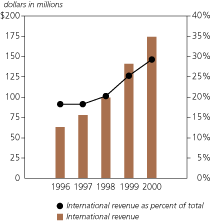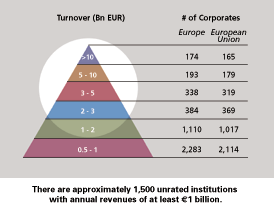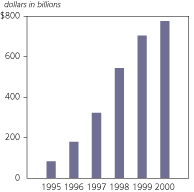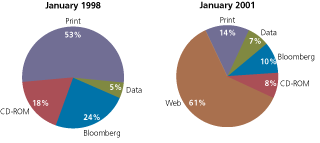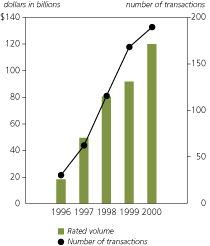| Our Strategies
Moody’s strategic direction is based on three key objectives: • Seize growth opportunities that flow from the worldwide expansion of capital markets Seizing global opportunities Global economic growth and capital markets evolution are creating important opportunities for Moody’s. As economic development, market liberalization, and disintermediation of financing sources create greater flows of capital in public markets, Moody’s role in facilitating borrowers’ and investors’ activities in those markets becomes more established and valuable.
To date, Moody’s has rated more than 800 European companies – a 50% increase in five years. As the share of corporate financing provided by banks continues to decline, Moody’s rating coverage will grow with more companies seeking access to the bond markets.
Similarly, the volume of structured transactions has risen sharply, reflecting the growing need of financial institutions to securitize assets and investor demand for highly rated securities. The complexity of these instruments increases the relevance of Moody’s ratings to both sides of the transaction: originators seek ratings that will enhance the marketability of their securities while investors rely on our detailed analyses to better understand the risks. During 2000, asset-backed issuance in Europe increased 33%, issuance of collateralized debt obligations went up by 117%, and the number of asset-backed commercial paper programs rose by 160%. We have taken a number of steps to meet the needs of these new European clients: • As we increase our staff in London, Frankfurt, Paris, Madrid, and Milan, we continue to emphasize the need for a staff of European nationals with mastery of regional business, culture, and language. • A more localized management structure in the region ensures efficient decision-making and better service for our European client base. • Established partnerships with various entities throughout the region achieve better connections to the local business communities. For example, our affiliation with Czech Rating Agency – our sixth global joint venture over the past two years – will solidify Moody’s relationships with many Eastern European entities as they seek market access through the regional financial center in Prague. • Expanded research on European issuers, and special studies and industry analyses, provide specific focus on issues pertinent to the European markets. Asia-Pacific For the third year in a row, Moody’s has been named Asia’s leading rating agency in a poll conducted by Finance Asia. Survey respondents cited Moody’s for the excellence of our research and the influence of our opinions. Japan A variety of factors have led to an increasing awareness of credit risk and thus greater demand for ratings in Japan. Key among these are the change in the nature of capital formation, the beginnings of disintermediation in the financial system, increasing reliance on market discipline, and use of consolidated accounting. A number of other positive influences on the evolution of Japanese financial markets appear to be well underway. These include a rising awareness of shareholder value, the sale of cross-shareholdings, regulatory reform, continued expansion of the structured finance sector by banks, and a decentralization of governmental authority. These developments create several opportunities for Moody’s, most notably: • A rise in the volume of rated securities, new business development, and increased demand for ratings on managed funds, bank loans, project financings, and debt issued by regional and local governments. • Expansion of ratings in new sectors such as structured finance as reform takes hold in Japan’s financial markets.
Looking ahead, Moody’s expects cyclical recovery in issuance of investment-grade bonds, thanks in part to lower interest rates along with a shift from short-term financing in 2000 toward longer-term issuance in 2001. Despite the adverse market conditions, Moody’s achieved important accomplishments such as: Expansion of syndicated loan ratings
• A new rating system now provides Moody’s with significant prospects for growth in Latin America. National Scale Ratings were first introduced in Brazil in 1999 to provide country-specific measures of creditworthiness. In developing markets, these ratings are proving valuable as an orientation to the rating process for borrowers that rely on an exclusively domestic funding base. Investors find that the national system provides better differentiation among credits in countries where low sovereign ratings create compression under Moody’s global rating scale. • Moody’s established an office in Mexico City in September 2000, receiving regulatory approval from Mexico’s Comisión Nacional Bancaria y de Valores to rate all types of securities and managed funds using the national scale rating system. This governmental approval encourages issuers and fund managers in the country’s fast-growing market to apply for Moody’s ratings and to use our research to guide their investment decisions. • In early 2000, Moody’s acquired a partnership interest in Clasificadora de Riesgo Humphreys Limitada, a Chilean rating agency. • In Canada, from our Toronto office, Moody’s has expanded activities in structured finance and project finance to meet growing demands for credit analysis and ratings in this growing market. Product development Moody’s has a successful track record of developing new products to meet the evolving needs of customers. Deep relationships with our client base of borrowers and investors enable us to uncover new customer needs at an early stage. Just as importantly, those relationships confer product placement capabilities that help us to readily achieve penetration of new products into our various customer sets. We anticipate continued development of our product offerings across all areas of the business, including new rating initiatives, extensions of our research services, and consulting activities that leverage our expertise. Just as we have effectively used the Internet to enhance our research clients’ interactions with Moody’s, we will continue to utilize technology in order to capitalize on and enhance our formidable market position. Here are some of our most recent initiatives: Rating Assessment Service (RAS) Portfolio Monitoring for Collateralized Debt Obligations (CDOs)
Brand extension: the $20 trillion bank loan market Moody’s reputation and brand identity are highly valuable assets. A key strategy is to leverage our position as a leading brand in financial services for new business development. We are committed to uncovering and seizing opportunities to which we can bring our name recognition, credibility, and authority to quickly and efficiently establish leading market positions in high growth businesses. At present, our most important brand extension activity is being pursued by Moody’s Risk Management Services (MRMS). By providing tools for risk assessments on small and medium size companies, MRMS extends Moody’s authority as an evaluator of credit quality beyond our traditional core in the bond markets and into the $20 trillion bank loan market. Moreover, MRMS is adapting modern quantitative techniques to the measurement of credit risk across companies of all sizes. In so doing, Moody’s seeks to become the only full-service provider able to meet the complete range of credit evaluation needs for the institutional lending and investment communities. A technology-driven outgrowth of the traditional rating business, MRMS provides a suite of tools for the analysis and management of credit risk. These include financial analysis software, quantitative risk assessment models, credit training programs, and credit risk management consulting. Used extensively by lenders worldwide, MRMS products support the evaluation of counterparty exposures on a credit-by-credit and portfolio basis.
Moody’s Financial Analyst™ enables lenders to readily identify important issues for further study when examining the credit risk profile of a given borrower. During 2000, Moody’s leadership position in this arena was bolstered by the acquisition of the software products group of Crowe Chizek & Company, LLP. As a result, Moody’s more than doubled its share in the commercial bank market for financial analysis and statistical spreadsheet software.
Last year, we also introduced the first of our RiskCalc™ models, which provide estimates of the probability of default (PD) for publicly traded as well as privately held companies. Driven by publicly available information and user-controlled inputs, RiskCalc incorporates advanced statistical methods to provide timely and objective assessments of credit quality. The first RiskCalc models covering North American public and private firms were released to an enthusiastic audience of commercial bankers. In addition, a core group of quantitatively-oriented bond investors were among the early adopters of the RiskCalc technology, providing early confirmation of Moody’s brand extension strategy. Additional RiskCalc models are being developed specifically for regional markets in Europe and Asia, as well as models designed for specific industry sectors such as financial institutions.
|
